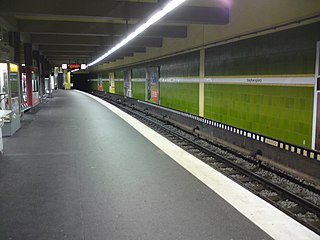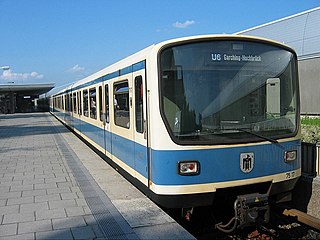
The Siemens Nexas is a class of electric multiple units manufactured by Siemens Transportation Systems for the suburban railway network of Melbourne, Australia between 2002 and 2005. The design of the trains was based on the Siemens Modular Metro.

The Hamburg U-Bahn is a rapid transit system serving the cities of Hamburg, Norderstedt, and Ahrensburg in Germany. Although referred to by the term U-Bahn, most of the system's track length is above ground. The network is interconnected with the city's S-Bahn system, which also has underground sections. It is operated by Hamburger Hochbahn within the Hamburger Verkehrsverbund (HVV). It was opened in February 1912, and comprises four lines serving 93 stations, with a route length of 106.4 kilometres (66.1 mi) in 2019.

Hamburger Hochbahn AG (HHA), founded in 1911, operates the underground system and large parts of the bus system in Hamburg, Germany. Its name comes from the initial name given to the Hamburg metro system, Hochbahn.

The ICE 1 is the first batch-produced German high-speed train and one of six in the Intercity Express family. Revenue service at speeds up to 250 km/h (155 mph) started in 1991. It was raised to 280 km/h (175 mph) in May 1995 and temporary reduced to 250 km/h (155 mph) again, as a result of the Eschede accident.

The Tokyo Metro 8000 series is an electric multiple unit (EMU) train type operated by Tokyo subway operator Tokyo Metro on the Tokyo Metro Hanzomon Line in Tokyo, Japan, since 1981.

Rapid transit in Germany consists of four U-Bahn systems and 14 S-Bahn systems. The U-Bahn, commonly understood to stand for Untergrundbahn, are conventional rapid transit systems that run mostly underground, while the S-Bahn or Stadtschnellbahn are commuter rail services, that may run underground in the city center and have metro-like characteristics in Munich, Hamburg and Berlin which they only have to a lesser extent in other cities. There are also over a dozen semi-metro or Stadtbahn systems that are rapid transit in the city center and light rail outside.
Transport in Hamburg comprises an extensive, rail system, subway system, airports and maritime services for the more than 1.8 million inhabitants of the city of Hamburg and 5.3 million people in the Hamburg Metropolitan Region.

The Type DT3 is a three-car electric multiple unit (EMU) train type operated by the Hamburger Hochbahn AG on the Hamburg U-Bahn.They were first introduced in 1968 to replace the 1911 to 1929-built Type T cars and to speed up the journey times on line U1.

The Type DT2 is a two-car electric multiple unit (EMU) train type operated by the Hamburger Hochbahn AG on the Hamburg U-Bahn until 2015. They replaced the Type T and Type TU.

The Type DT1 is a two-car electric multiple unit (EMU) train type operated by the Hamburger Hochbahn AG on the Hamburg U-Bahn until 1991. They were the first new U-Bahn trains since the 1920s.

The Type A is an electric multiple unit (EMU) train type formerly operated on the Hamburg U-Bahn system. They were the first type of subway cars in Hamburg, entering service on 15 February 1912, and were later designated as Type T. Some cars were converted to maintenance service cars.

Stephansplatz station is a metro station served by Hamburg U-Bahn line U1. It is located at Stephansplatz in the Neustadt quarter of Hamburg.

The Class G is an electric multiple unit train type used on the Berlin U-Bahn. The trains were originally developed for the Berliner Verkehrsbetriebe of East Berlin.

Ochsenzoll is a station on the Hamburg U-Bahn line U1. Until 1969, it was the north western terminus of the line. It was opened in July 1921 and is located in Hamburg, Germany, in the quarter of Langenhorn. Langenhorn is part of the borough of Hamburg-Nord.

The MVG Class B is an electric multiple unit (EMU) train type operated by the Münchner Verkehrsgesellschaft on the Munich U-Bahn system. The prototypes were delivered in 1981, and the full-production units from 1987. A derivative of the Class B, the VAG Class DT2, is in service on the Nuremberg U-Bahn system.

The MVG Class C is an electric multiple unit (EMU) train type operated by the Münchner Verkehrsgesellschaft on the Munich U-Bahn system since 2002. It is the first type of rolling stock on the Munich U-Bahn that consists of more than two cars and features gangways between the individual cars.

The VAG Class DT2 is an electric multiple unit (EMU) train type operated by the Verkehrs-Aktiengesellschaft Nürnberg on the Nuremberg U-Bahn system. It is a derivative of the MVG Class B, in service on the Munich U-Bahn since 1981.

The LRTA 1100 class is the second-generation class of high-floor light rail vehicles of the LRT Line 1.

The Type DT5 is an electric multiple unit (EMU) train type operated by the Hamburger Hochbahn AG on the Hamburg U-Bahn system. It is the first type of rolling stock on the Hamburg U-Bahn that has air conditioning and gangways between the individual cars.






















